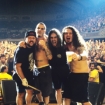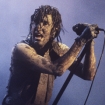Revolver has teamed with Pantera for limited-edition colored vinyl pressings of the band's classic albums plus a new Pantera collector's issue. Quantities are extremely limited — get yours before they're gone!
Anyone looking for the most extreme and abrasive Pantera album should make a beeline to 1996's The Great Southern Trendkill. Characteristically defiant and contrarian, the band followed up its No. 1 Billboard-charting album Far Beyond Driven with an LP that was far beyond confrontational — musically experimental, sonically bombastic and lyrically scathing.
Trendkill was Pantera at their most pissed-off, stubborn and subversive. At a time when Korn, Marilyn Manson and Tool were pioneering new MTV-friendly styles of metal and even Metallica were skewing alternative, Pantera became less accessible and more fucking hostile, writing riffs that were dissonant and disorientating. Phil Anselmo — drawing on his personal pain, isolation and self-loathing — lashed out with unrelenting disgust at society ("War Nerve," "The Great Southern Trendkill"), self-indulgent hipsters ("Drag the Waters," "(Reprise) Sandblasted Skin") and himself ("10's," "Living Through Me (Hell's Wrath").
"It was a bit of a dark-horse record for Pantera, because heavy metal, at the time, was supposed to be on its way out," Anselmo said in a radio interview. "Grunge was the No. 1–selling genre at the time. Heavy metal was being experimented with by different bands, in different ways, and, really, from the Pantera perspective, we really, really, really, really wanted to fly the pure Pantera style of heavy metal as best we could. And we did."
Despite the well-documented tension growing between Anselmo and the Abbott Brothers — guitarist Dimebag Darrell and drummer Vinnie Paul — the band did what they could to keep their personal friction off the album and off the stage. "Even if we were feeling the strain, we didn't let it show," Vinnie Paul said. "The fans were there for us. It was probably the most abrasive, obnoxious record we ever made. It was out of control, and it was out of control in more ways than just the music. The people that were a part of it were out of control, the whole thing was out of control, I don't even know how we finished it."
Despite the behind-the-scenes turmoil and the LP's antagonistic nature, the album was embraced by diehard fans: Less than two months after it was released, The Great Southern Trendkill went gold and in August 2004 it was certified Platinum by the RIAA. In celebration of Pantera's most punishing album, here are seven facts you likely didn't know about The Great Southern Trendkill.
1. The band underwent a last-minute studio change and ended up recording at Dimebag Darrell's home
Pantera had planned to record the album at a professional studio in Dallas, but after they started jamming at Dimebag's practice pad, they decided to record there instead of the more established locale. "It started off as a jam room," Dime told Guitar World of his home studio. "But then we decided to do our demos here, so we brought in some gear — three Tascam DA-88's and a little Mackie board. The demos were so tough and lethal sounding that we were like, 'Man! That's almost it, right there.' Then we got hold of an MCI5OO console — the board we've used to record all our albums — and we were set [with] a full studio."
2. Phil Anselmo recorded his vocals at Trent Reznor's studio in NOLA
Anselmo worked with the rest of Pantera during the preliminary sessions for Trendkill, but recorded all his vocals at Trent Reznor's studio in New Orleans. In part, he wanted some personal space, but he also didn't want his bandmates to see him high on painkillers, which he first used to treat his agonizing back pain. "Well, it was very interesting times and very trying times as well," Anselmo told a radio show. "On a personal level, I wasn't doing all that well because I was injured, I was making every rookie mistake in the world with pain medication and I was embarrassed. I didn't wanna see anybody, man. I was in a bad way ... [So] I did decide to do my vocals on my own."
3. Rex Brown spotted the signs of Anselmo's drug use during the making of the album
In the early stages of Trendkill preparation, Anselmo's party buddy and closest ally in the band, bassist Rex Brown, figured out that the singer was using heroin. "Back then, we would wake and bake," Brown told Guitar World. "That was just a given. So that made us a little foggy. But at one point I noticed Phil was fuzzier than usual. One day when we started doing The Great Southern Trendkill, he looked at me and slapped his armpit, and I went, 'What?!' I've never stuck a needle in my arm. I used to watch some of my friends shoot up, but I would never do it. No way. I hadn't seen that reference in 10 years, and Philip doing that at me made me go, 'Oh shit! I hope he's not doing what I think he's doing.' Sure enough, he was doing smack. And he was a wreck through the writing sessions of Trendkill. We were all so burned out by that point. A lot of the discipline and structure we used to have went out the window." On July 13th, 1996, while on tour in support of the album, Anselmo would, of course, O.D. after a hometown show in Dallas.
4. Dimebag built the legendary solo in "Floods" from stuff he'd improvised onstage
The guitar solo in "Floods," which is considered one of Dime's best ever, stemmed from passages he played onstage between songs during the Far Beyond Driven tour. "I used to play a 20-minute solo that consisted of everything from [Eddie Van Halen's] "Eruption" to [Randy Rhoads'] "(Revelation) Mother Earth" — plus whatever else I felt like throwing in," Dime told Guitar World. "A regular part of my solo featured a long-assed, 'sing-along' type lead section, which ended up in 'Floods.'"
"It was the first time Philip didn't track vocals with us, which left Dime leery because he didn't know what to do with the leads," Brown said to Guitar World. "But he got it done anyway and it was killer. Just listen to 'Floods.' That's the three of us locked in and it's got all these different shades to it and all these dynamics and Dime's solo couldn't be better."
5. Anselmo brought in a special guest vocalist, Anal Cunt's Seth Putnam
The late frontman of Anal Cunt, the defiantly politically incorrect Seth Putnam, contributed background screams to The Great Southern Trendkill songs "War Nerve," "13 Steps to Nowhere" and "Suicide Note Pt. II." Anselmo returned the favor via his backing vocals on 18 songs on Anal Cunt's 1996 album, 40 More Reasons to Hate Us. "Seth had a bizarre, absurd sense of humor that pissed a lot of people off, but the way Seth saw it, that's what they were, just 'a lot of pissed-off people,'" Anselmo told Decibel of Putnam after his death. "I got his humor like the back of my fist."
6. Dimebag directed the "Drag the Waters" video
Dimebag hardly went anywhere without his video camera — a good thing for fans of the Pantera "home videos," and for fans of the gritty clip for Trendkill single "Drag the Waters," which was directed by the guitarist. He described the song in press materials as being "about a lifetime of dealing with people that you can't tell what they're really comin' at you for, or what their motives really are. You've got to drag the waters to get to the bottom and find out the truth." The entire video is in black and white, and it starts with the message, "In everyday life, there is more than meets the eye. To reach the depths of truth we must drag the waters." The clip includes live band shots, along with narrative footage of criminals being chased by cops, a dodgy scene in a warehouse and clips of Anselmo lip-synching and looking strung out and super-pissed off.
7. Electronic artist Moby digs the album
The Great Southern Trendkill is one of Pantera's most divisive albums, but it has its ardent fans, maybe none more unlikely than electronic composer and DJ Moby, who cites it as one of his favorite metal albums. "[It's]so unrelentingly dark," he told Classic Rock magazine. "The lyrics of 'War Nerve' are the most unrelentingly evil lyrics you can imagine. They make church-burning Norwegian Satanists sound like Sunday school teachers. It's just that whole vituperative expression of anger and rage."








